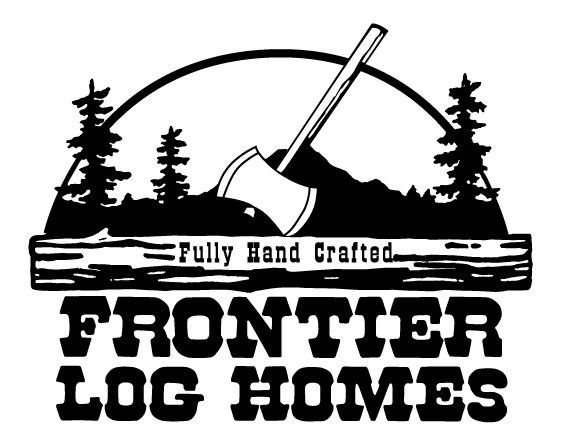Besides offering protection from the elements, roofs add style to a home. Some assume that a log house can only have a wooden roof, but that’s not the case. In fact, there are plenty of roof materials, colors, and textures to choose from. The choice depends on your budget, the weather conditions in your area, and your log home’s architectural style.
The most common roof materials are shingles, metal, ceramic tiles, and slate. Each has its distinct advantages but also drawbacks. For instance, some materials work better in wet conditions, while others are perfect for hot and dry climates.
As a log home construction company, Frontier Log Homes can install the roof material that matches your exact needs and expectations.
Roof Materials for Your Log Home
When we design your log home, we consider the roof material you have chosen because we must design your structure to support it. The most common options include shingles, metal roofs, ceramic tiles, and green roofs.
Shingles and Architectural Shingles
The most common roof material is asphalt shingles. Shingles are made of fiberglass or other fibers that are coated in asphalt.
Shingles can last up to 25 years and come in various colors to match your log home’s architectural style and overall colors.
One significant advantage of shingles is their low weight, making it easy for installers to lift and install them on the roof structure. In addition, they are fire-resistant. Shingles are a safe choice if your log home is located in an area prone to wildfires.
On the other hand, shingles can crack or lift with high winds or extreme heat. They also tend to discolor with time. If you notice sand granules accumulating in your gutters, the asphalt coating of your shingles is slowly disintegrating, and it may be time to re-roof your log home.
Some of these issues are mitigated with architectural shingles. They are more expensive than standard shingles and add texture and character to your roof. They are heavier and less prone to lifting.
Metal Roofs
Metal roofs are commonly made from steel, copper, aluminum, or zinc. The choice rests with homeowners and how they picture their log home.
Metal roofs have a lifespan that stretches to 50 years, which saves you a lot on re-roofing. They are coated with an anti-corrosion substance to help the metal withstand water corrosion and chipping.
Builders can cut metal sheets to any size and shape, making them highly adaptable to any roof area.
Metal roofs are coated with reflective substances to keep sunlight at bay. With the help of some good insulation under your roof, this roof will highly insulate your home from heat and cold.
However, while metal roofs are lightweight, fireproof, and weatherproof, they cost more than shingles. Also, some homeowners find metal roofs a bit rough-looking and reminiscent of barns and farm buildings. Thankfully, technology has developed metal compounds that look appealing and match various architectural styles.
Clay/Ceramic Tiles
Clay tiles are evocative of Italian summer houses. They were originally made by hand, and their craftsmanship added character and texture to a roof. Modern clay or ceramic tiles are machine-made and kiln-fired to look identical and ensure easier installation.
Ceramic roofs are sustainable and add a touch of organic, rustic elegance to log homes. They are also highly insulating and fireproof.
However, they are more expensive than shingle roofs. Also, clay tiles are heavy, so you need to reinforce your roofing structure to support the weight of the tiles. In addition, they require frequent maintenance to replace broken tiles—although this may be seen as a good thing, since it means that you won’t have to redo the whole roof.
Slate Roofs
Slate roofs used to be the norm but are less common today, mainly because they are heavier and more expensive than other roof options.
Slate roofs are constructed with overlapping slate tiles, positioned so that the weight of each one keeps the next one in place.
If you choose to install a slate roof, you must build a heavier and stronger structure that will carry the weight of the slates.
Slate tile purchase and installation are expensive but a slate roof will last you a lifetime. Slate tiles are fireproof, weather resistant, and can withstand rain, snow, and extreme heat. As a nod to the past, slate roofs provide log homes with an elegant yet rustic touch.
Green Roofs
There is increasing talk of green roofs. Green roofs are covered in vegetation that is adapted to local conditions and acts as powerful insulation against both noise and the elements.
Green roofs blend with the surrounding vegetation and add rusticity to your home’s look. Their insulating properties help increase your energy efficiency and reduce noise. They extend your roof’s lifespan because they are not exposed to rain, snow, wind, or sunlight.
Log homes are considered healthier, partly because we use non-toxic sealants and because timber is carbon negative from cradle to gate. Green roofs improve air quality even further. They also help support wildlife and often attract birds to create an eco-friendly habitat.
Since they’re heavier than other roof types, you must ensure your log home roof can support its weight before installing it. Drainage is hard to install and maintain, requiring watering, weeding, and fertilizing.
Trust Frontier Log Homes for the Best Roof Materials
Our log home technicians have the expertise and exquisite craftsmanship you need. Through the design process, they will mention all the available roof material choices. You can then decide which material fits your budget and matches the aesthetic of your log home. We also offer a variety of floor plan options in our luxurious log home kits.
Call us at 970-249-7130, and let’s start building your dream log home!

